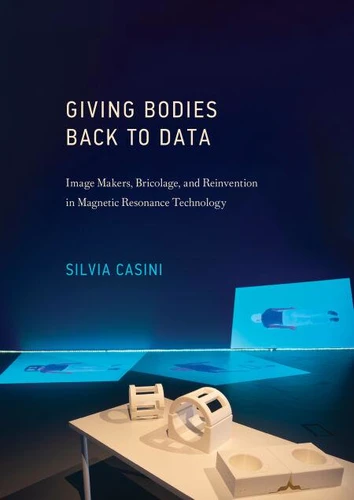Giving Bodies Back to Data. Image Makers, Bricolage, and Reinvention in Magnetic Resonance Technology
Par :Formats :
Disponible dans votre compte client Decitre ou Furet du Nord dès validation de votre commande. Le format ePub protégé est :
- Compatible avec une lecture sur My Vivlio (smartphone, tablette, ordinateur)
- Compatible avec une lecture sur liseuses Vivlio
- Pour les liseuses autres que Vivlio, vous devez utiliser le logiciel Adobe Digital Edition. Non compatible avec la lecture sur les liseuses Kindle, Remarkable et Sony
- Non compatible avec un achat hors France métropolitaine
 , qui est-ce ?
, qui est-ce ?Notre partenaire de plateforme de lecture numérique où vous retrouverez l'ensemble de vos ebooks gratuitement
Pour en savoir plus sur nos ebooks, consultez notre aide en ligne ici
- Nombre de pages312
- FormatePub
- ISBN978-0-262-36220-7
- EAN9780262362207
- Date de parution03/08/2021
- Protection num.Adobe DRM
- Taille76 Mo
- Infos supplémentairesepub
- ÉditeurThe MIT Press
Résumé
An examination of the bodily, situated aspects of data-visualization work, looking at visualization practices around the development of MRI technology. Our bodies are scanned, probed, imaged, sampled, and transformed into data by clinicians and technologists. In this book, Silvia Casini reveals the affective relations and materiality that turn data into image--and in so doing, gives bodies back to data.
Opening the black box of MRI technology, Casini examines the bodily, situated aspects of visualization practices around the development of this technology. Reframing existing narratives of biomedical innovation, she emphasizes the important but often overlooked roles played by aesthetics, affectivity, and craft practice in medical visualization. Combining history, theory, laboratory ethnography, archival research, and collaborative art-science, Casini retrieves the multiple presences and agencies of bodies in data visualization, mapping the traces of scientists' body work and embodied imagination.
She presents an in-depth ethnographic study of MRI development at the University of Aberdeen's biomedical physics laboratory, from the construction of the first whole-body scanner for clinical purposes through the evolution of the FFC-MRI. Going beyond her original focus on MRI, she analyzes a selection of neuroscience- or biomedicine-inspired interventions by artists in media ranging from sculpture to virtual reality.
Finally, she presents a methodology for designing and carrying out small-scale art-science projects, describing a collaboration that she herself arranged, highlighting the relational and aesthetic-laden character of data that are the product of craftsmanship and affective labor at the laboratory bench.
Opening the black box of MRI technology, Casini examines the bodily, situated aspects of visualization practices around the development of this technology. Reframing existing narratives of biomedical innovation, she emphasizes the important but often overlooked roles played by aesthetics, affectivity, and craft practice in medical visualization. Combining history, theory, laboratory ethnography, archival research, and collaborative art-science, Casini retrieves the multiple presences and agencies of bodies in data visualization, mapping the traces of scientists' body work and embodied imagination.
She presents an in-depth ethnographic study of MRI development at the University of Aberdeen's biomedical physics laboratory, from the construction of the first whole-body scanner for clinical purposes through the evolution of the FFC-MRI. Going beyond her original focus on MRI, she analyzes a selection of neuroscience- or biomedicine-inspired interventions by artists in media ranging from sculpture to virtual reality.
Finally, she presents a methodology for designing and carrying out small-scale art-science projects, describing a collaboration that she herself arranged, highlighting the relational and aesthetic-laden character of data that are the product of craftsmanship and affective labor at the laboratory bench.
An examination of the bodily, situated aspects of data-visualization work, looking at visualization practices around the development of MRI technology. Our bodies are scanned, probed, imaged, sampled, and transformed into data by clinicians and technologists. In this book, Silvia Casini reveals the affective relations and materiality that turn data into image--and in so doing, gives bodies back to data.
Opening the black box of MRI technology, Casini examines the bodily, situated aspects of visualization practices around the development of this technology. Reframing existing narratives of biomedical innovation, she emphasizes the important but often overlooked roles played by aesthetics, affectivity, and craft practice in medical visualization. Combining history, theory, laboratory ethnography, archival research, and collaborative art-science, Casini retrieves the multiple presences and agencies of bodies in data visualization, mapping the traces of scientists' body work and embodied imagination.
She presents an in-depth ethnographic study of MRI development at the University of Aberdeen's biomedical physics laboratory, from the construction of the first whole-body scanner for clinical purposes through the evolution of the FFC-MRI. Going beyond her original focus on MRI, she analyzes a selection of neuroscience- or biomedicine-inspired interventions by artists in media ranging from sculpture to virtual reality.
Finally, she presents a methodology for designing and carrying out small-scale art-science projects, describing a collaboration that she herself arranged, highlighting the relational and aesthetic-laden character of data that are the product of craftsmanship and affective labor at the laboratory bench.
Opening the black box of MRI technology, Casini examines the bodily, situated aspects of visualization practices around the development of this technology. Reframing existing narratives of biomedical innovation, she emphasizes the important but often overlooked roles played by aesthetics, affectivity, and craft practice in medical visualization. Combining history, theory, laboratory ethnography, archival research, and collaborative art-science, Casini retrieves the multiple presences and agencies of bodies in data visualization, mapping the traces of scientists' body work and embodied imagination.
She presents an in-depth ethnographic study of MRI development at the University of Aberdeen's biomedical physics laboratory, from the construction of the first whole-body scanner for clinical purposes through the evolution of the FFC-MRI. Going beyond her original focus on MRI, she analyzes a selection of neuroscience- or biomedicine-inspired interventions by artists in media ranging from sculpture to virtual reality.
Finally, she presents a methodology for designing and carrying out small-scale art-science projects, describing a collaboration that she herself arranged, highlighting the relational and aesthetic-laden character of data that are the product of craftsmanship and affective labor at the laboratory bench.



